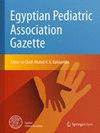Diagnostic and prognostic utility of prealbumin as a nutritional biomarker in critically ill children: a prospective cross sectional study
IF 0.5
Q4 PEDIATRICS
引用次数: 0
Abstract
Abstract Background Paediatric intensive care units (PICU) experience a big challenge with malnutrition. It significantly impacts the development and prognosis of critically ill patients (CIP). CIP are those who require high reliance or serious medical and/or surgical interventions. For their importance, valid and reliable nutritional markers are mandatory to be implemented in the daily practice of our PICU. The aim of this study was to determine the nutritional status of CIP in PICU through measuring prealbumin level and use it as predictor of malnutrition and clinical outcome. Methods Forty four CIP admitted to the Children's Hospital, Cairo University PICU, throughout six months were the subject of this cross-sectional study. Clinical nutritional status was evaluated using the Z-score, and prealbumin level was measured. Results 50% of children who were critically sick also had malnutrition, with severe malnutrition accounting for the majority of cases (34.1%). Prealbumin did not significantly correlate with malnutrition, nor the mortality in CIP. However, malnutrition is strongly linked to mortality in critically ill children. To predict malnutrition in CIP, serum prealbumin at cutoff > 163.64 exhibited AUC of 0.556 with sensitivity of 90.91% and a specificity of 31.82%. For prediction of the clinical outcome, serum prealbumin at cutoff ≤ 758.37 had an AUC of 0.535 with a sensitivity of 91.67% and a specificity of 21.87%. Conclusions Malnutrition significantly increased the risk of death. Prealbumin was neither a significant predictor for malnutrition nor mortality in CIP.前白蛋白作为一种营养生物标志物在危重儿童中的诊断和预后应用:一项前瞻性横断面研究
儿科重症监护病房(PICU)面临着营养不良的巨大挑战。它对危重患者(CIP)的发展和预后有显著影响。CIP是那些需要高度依赖或严重的医疗和/或手术干预的人。鉴于其重要性,在PICU的日常实践中必须实施有效可靠的营养标记。本研究的目的是通过测量前白蛋白水平来确定PICU中CIP的营养状况,并将其作为营养不良和临床预后的预测指标。方法对开罗大学儿童医院PICU住院6个月的44例CIP患儿进行横断面研究。采用Z-score评估临床营养状况,并测定前白蛋白水平。结果50%的危重患儿同时存在营养不良,其中重度营养不良患儿占多数(34.1%)。前白蛋白与CIP患者的营养不良和死亡率没有显著相关性。然而,营养不良与危重儿童的死亡率密切相关。目的:预测CIP患者营养不良;163.64的AUC为0.556,灵敏度为90.91%,特异性为31.82%。对于临床预后的预测,在临界值≤758.37时,血清前白蛋白的AUC为0.535,敏感性为91.67%,特异性为21.87%。结论营养不良显著增加死亡风险。前白蛋白不是CIP患者营养不良和死亡率的显著预测因子。
本文章由计算机程序翻译,如有差异,请以英文原文为准。
求助全文
约1分钟内获得全文
求助全文
来源期刊

Egyptian Pediatric Association Gazette
PEDIATRICS-
自引率
0.00%
发文量
32
审稿时长
9 weeks
期刊介绍:
The Gazette is the official journal of the Egyptian Pediatric Association. The main purpose of the Gazette is to provide a place for the publication of high-quality papers documenting recent advances and new developments in both pediatrics and pediatric surgery in clinical and experimental settings. An equally important purpose of the Gazette is to publish local and regional issues related to children and child care. The Gazette welcomes original papers, review articles, case reports and short communications as well as short technical reports. Papers submitted to the Gazette are peer-reviewed by a large review board. The Gazette also offers CME quizzes, credits for which can be claimed from either the EPA website or the EPA headquarters. Fields of interest: all aspects of pediatrics, pediatric surgery, child health and child care. The Gazette complies with the Uniform Requirements for Manuscripts submitted to biomedical journals as recommended by the International Committee of Medical Journal Editors (ICMJE).
 求助内容:
求助内容: 应助结果提醒方式:
应助结果提醒方式:


